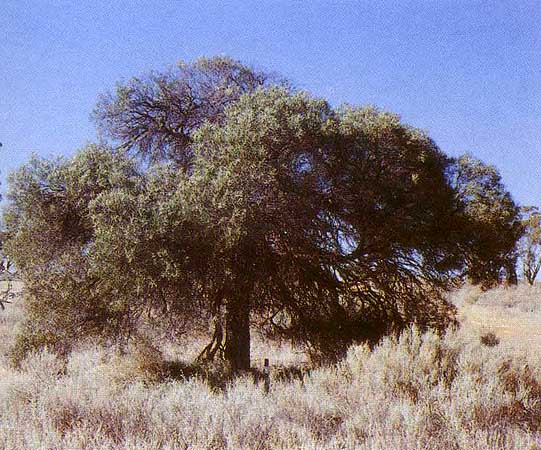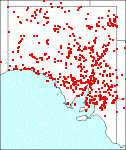Family: Fabaceae
Acacia oswaldii

Citation:
F. Mueller, Pl. lndig. Colon. Vic. 2:27 (1863).
Derivation: oswaldii—in honour of Mr Ferdinand Oswald, formerly resident of Adelaide, later Nordhausen,Germany.
Synonymy: Racosperma oswaldii (F. Muell.)Pedley, Austrobaileya 2:353 (1987).
, Acacia sessiliceps Common name: umbrella wattle
Description:
Dense, rounded, spreading shrubs or small trees 2-6 m high with bushy umbrageous canopies, a straight trunk often for about 1 m above ground level before branching, or with several small stems from base; branchlets pubescent, slightly angular becoming terete; bark hard, rough, fissured and dark grey.
Phyllodes linear, oblong-lanceolate, 3-8 cm long, 2-10 mm broad, flat, thick, rigid, striate, silvery or somewhat golden pubescent when young, becoming glabrous with age, numerous fine parallel more or less prominent veins, apex acute or obtuse usually with a straight or curved pungent point; glands basal.
Inflorescences simple and axillary, solitary or mostly twin, sessile or on very short pubescent peduncles; flower-heads more or less globular, 10-15-flowered; flowers 5-merous.
Legumes linear, somewhat moniliform, 5-17 cm long, 7-10 mm broad, much-curved spirally twisted, coriaceous to woody, hoary. Seeds longitudinal in legume; funicle short, yellowish-orange, usually folded beneath the seed ending in a broad fleshy aril.
|
|
Distribution:
|
Widely scattered in semi-arid and arid regions of S.Aust. Occurs in open woodland or tall shrubland to open scrub, often associated with Acacia aneura, Casuarina cristata and Eucalyptus socialis. Soils; mainly calcareous loamy or sandy earths. Rainfall 150-500 mm. Also W.Aust., N.T., Qld, N.S.W. and Vic.
S.Aust.: NW, LE, NU, GT, FR, EA, EP, NL, MU, YP, SL.
|
Flowering time: Irregular periods throughout the year, mainly summer.
|

SA Distribution Map based
on current data relating to
specimens held in the
State Herbarium of South Australia
|
Biology:
No text
Related taxa:
Appears very closely allied to Acacia sessiliceps F. Muell. from which it differs mainly in broader phyllodes. The variation and gradation to the narrow phyllode forms, similar sessile flower-heads and legume characters makes these two species difficult to distinguish. See also L. Pedley (1978). Further investigation into these two species is required to ascertain whether Acacia sessiliceps can be satisfactorily distinguished from A. oswaldii.
Taxonomic notes:
Lange & Graham (1983) conducted experiments on the influence of rabbits on Acacia regeneration in the arid areas. A. oswaldii was amongst the four species tested. Results showed that seedlings were severely pruned even with lowered post-myxomatosis rabbit population densities. Rabbit grazing pressure would significantly affect the recruitment in arid zone Acacia populations.
Despite its wide distribution only three mistletoes have been recorded on A. oswaldii in the State Herbarium. There are two records of Lysiana exocarpi, harlequin mistletoe, more records of Amyema preissii, wire-leaved mistletoe and a couple of records of Amyema maidend, pale-leaved mistletoe.
Everist (1981) records stock poisoning by Acacia oswaldii believing the toxic substance to be cyanides in the leaves.
The small pale flowers and somewhat malodorous leaves are hardly likely to make this a popular species in cultivation. It has a dense growth habit and its wide distribution in the State indicates tolerance of many soil types.
Cultivation:
Useful bushy shrub or small tree for planting in inland areas. Moderate growth rate.
Author:
Not yet available
Source:

|

